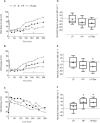Consumption of High-Leucine-Containing Protein Bar Following Breakfast Impacts Aminoacidemia and Subjective Appetite in Older Persons
- PMID: 34104852
- PMCID: PMC8178109
- DOI: 10.1093/cdn/nzab080
Consumption of High-Leucine-Containing Protein Bar Following Breakfast Impacts Aminoacidemia and Subjective Appetite in Older Persons
Abstract
Background: Limited data are available examining dietary interventions for optimizing protein and leucine intake to stimulate muscle protein synthesis (MPS) in older humans.
Objectives: We aimed to investigate the aminoacidemia and appetite responses of older adults after consuming breakfast, a meal frequently consumed with high-carbohydrate and below-par amounts of protein and leucine for stimulating MPS.
Methods: Five men and 3 women (means ± SD; age: 74 ± 7 y, BMI: 25.7 ± 4.9 kg/m2, fat- and bone-free mass: 63 ± 7 kg) took part in this experiment in which they consumed breakfasts with low-protein (LP = 13 ± 2 g), high-protein (HP = 32 ± 5 g), and LP followed by a protein- and leucine-enriched bar formulation 2 h later (LP + Bar = 29 ± 2 g). The LP, HP, and LP + Bar breakfast conditions contained 519 ± 86 kcal, 535 ± 83 kcal, and 739 ± 86 kcal, respectively. Blood samples were drawn for 6 h and analyzed for amino acid, insulin, and glucose concentrations. Visual analog scales were assessed for hunger, fullness, and desire to eat.
Results: The net AUC for essential amino acid (EAA) exposure was similar between the LP + Bar and HP conditions but greater in the HP condition compared with the LP condition. Peak leucinemia was higher in the LP + Bar condition compared with the HP, and both were greater than the LP condition. Net leucine exposure was similar between HP and LP + Bar, and both were greater than LP. Hunger was similarly reduced in LP + Bar and HP, and LP + Bar resulted in a greater hunger reduction than LP. Both LP + Bar and HP resulted in greater net fullness scores than LP.
Conclusions: Consuming our bar formulation increased blood leucine availability and net exposure to EAAs to a similar degree as consuming a high-protein meal. High-protein at breakfast results in a greater net exposure to EAAs and leucine, which could support MPS in older persons. This study was registered at clinicaltrials.gov as NCT03712761.
Keywords: aging; amino acids; dietary intervention; milk protein; muscle preservation; randomized trial; sarcopenia; satiety; supplement.
© The Author(s) 2021. Published by Oxford University Press on behalf of the American Society for Nutrition.
Figures



References
-
- Billot M, Calvani R, Urtamo A, Sánchez-Sánchez JL, Ciccolari-Micaldi C, Chang M, Roller-Wirnsberger R, Wirnsberger G, Sinclair A, Vaquero-Pinto Net al. . Preserving mobility in older adults with physical frailty and sarcopenia: opportunities, challenges, and recommendations for physical activity interventions. Clin Interv Aging. 2020;15:1675–90. - PMC - PubMed
-
- Cuthbertson D, Smith K, Babraj J, Leese G, Waddell T, Atherton P, Wackerhage H, Taylor PM, Rennie MJ. Anabolic signaling deficits underlie amino acid resistance of wasting, aging muscle. FASEB J. 2005;19(3):1–22. - PubMed
-
- Moore DR, Churchward-Venne TA, Witard O, Breen L, Burd NA, Tipton KD, Phillips SM. Protein ingestion to stimulate myofibrillar protein synthesis requires greater relative protein intakes in healthy older versus younger men. J Gerontol A Biol Sci Med Sci. 2015;70(1):57–62. - PubMed
Associated data
LinkOut - more resources
Full Text Sources
Medical
Research Materials
Miscellaneous

